‘For those who are convinced of the harmfulness of the corset, a variety of articles called corset-waists are made.’ (Beauty: Its Attainment And Preservation, 1896)
In the late Victorian and Edwardian era, some women preferred to wear a health corset. Health corsets had a button closure at the center front instead of the typical steel corset busk, had shoulder straps and were made of white or blue jean (a strong, durable twill-weave cotton fabric similar to denim fabric). They also were either unboned and stiffened with cord, or just lightly boned – and some even had elastic insets at the front and sides!
A health corset ‘fits and adapts itself to the form of the wearer more perfectly, and […] can be worn with greater ease and comfort than any heretofore made’. (Corset Patent, 1884)
In the Edwardian era, health corsets were usually called “corset waists”, “athletic corsets”, “hygienic waists” and “sanitary corsets”. Health corsets were worn for sport but also by pregnant women and young mothers. While there were other brands, health corsets are almost synonymous with the Ferris brand.
‘When Ferris’ Good Sense Corset Waist is on the form the wearer is satisfied she looks right; she knows she feels right; she has the physician’s assurance that she is dressed right for health. All who have worn them express their satisfaction with Ferris’ Good Sense Corset Waist.’ (Ferris Corset Ad & Picture, 1898)
What Is An Edwardian Health Corset?
‘Although corset waists are by no means corsets, they are so closely allied to corsets […] As a rule, corset waists are made on very straight lines.’ (Corsets And Close-Fitting Patterns, 1915). ‘Some ladies like waists better than corsets […] They are as soft and pliable as a waist can be’ (Perfection Waists, 1895).
The health corset is ‘a corset simple in its construction, easily and conveniently adjusted, and without mobility or shifting while worn; second, a corset securing symmetry of form and affording a stay and support to the trunk and abdomen with ease and comfort to the wearer and yielding adjustments at any desirable point;
third, a corset by the proper use of which the form and figure of the wearer may be molded and fashioned to please and gratify the individual taste and fancy, obesity reduced to the minimum, and the lean and lank agreeably rounded out, and the health improved and promoted.’ (Corset Patent, 1897)
Health corsets were often worn for sports, such as cycling, riding, tennis and golf.
Related: Edwardian Sport Corset
‘The perfect poise of the woman who wears a Ferris Waist is easily distinguishable. She rides with easy grace because every motion, every muscle is absolutely free. She rides without fatigue because she enjoys perfect respiration. Ferris’ Bicycle Corset Waist is constructed with elastic sides which yield to every motion of the wearer. The hips are short and pliable, the bust is made to give support without restriction. Every woman who rides a wheel or a horse, who plays tennis or golf, should wear the Ferris Bicycle Corset Waist.’ (Ferris Corset Ad & Picture)
My Inspirations
These three antique late Victorian and Edwardian Ferris health corsets were my inspiration for my health corset reproduction: 1900s Ferris Good Sense Corset Waist, 1890s Ferris Maternity Corset and 1890s Ferris Sport Corset.
More pictures of antique health corsets on my pinterest board ‘1900s Lingerie’.
The Pattern
I used the following free antique corset pattern: 1897 corset patent. Corset patents should be used with caution because they were often designed for unusual requirements!
I usually adapt antique corset patterns so that they fit my waist (minus the lacing gap at the back) and then all other measurements are usually close enough. After all, the corset is used to shape the body – and the body has to adapt to the corset so that the historical silhouette is right. But this corset was different! It was one of the strangest antique corset patterns I’ve used so far! The corset was obviously for a short-waisted women with ridiculously large bust and hip measurements. Moreover, the panels at the shoulder were curved creating a hump at the back!
Modifying The Pattern
Ferris Good Sense corset waists ‘are not made after exaggerated “French patterns,” but are made to conform to the natural beauty of model forms’ (Ferris Good Sense Waist Ad, 1902).
To adapt the pattern to my figure, I lengthened all panels, reduced the bust and hip width, eliminated the elastic insets, and trimmed the curved panels at the back so that the seams are straight. I also reshaped the shoulder strap piece and almost all panels so that the corset looked more like Ferris “Good Sense” corsets.
Although I make mockups for all my historical costumes, I never make corset mockups with fabric: I make paper mockups instead. Because corsets are structured, stiff garments, paper mockups are, in my opinion, better suited to show the shape of the corset. On my instagram account I shared the paper corset mockup of the adapted Edwardian health corset pattern.
Fabric
Popular corset fabrics in the Edwardian era were corset jean, sateen and coutil. All three fabrics were made of 100% cotton, tightly woven, strong and sturdy. But there’s a difference in the weave: corset jean is twill weave fabric, usually white or blue, coutil is herringbone – broken twill weave – fabric, usually white or drab, while sateen is satin weave fabric. For my Edwardian health corset I used white cotton twill fabric.
‘Ladies’ Ferris Waist, made of jean, medium form, long waist, colors white, drab and black, size 18 to 30′ (Eaton’s Spring And Summer Catalogue, 1904).
And here’s an antique Edwardian Ferris Good Sense Bicycle Athletic Corset in dark blue jean.
Construction Details
The style of the corset is a straight-front style which was very fashionable in the Edwardian era.
Related: Edwardian Straight-Front Silk Corset
It’s constructed of 16 panels – not including the shoulder straps. The corset measures 31.5″ (80cm) across the bust, with a 23″ (58cm) waist and a hip of only 29″ (74cm) – all these measurements are not including the lacing gap at the back. The busk is 15″ (37.5cm) long.
I constructed the corset using the welt seam method because this creates very strong and durable corsets. Apart from the cording and boning, the two fabric layers and welt seams add some stiffening as well.
Cording & Boning
Edwardian health corsets were usually stiffened with cords, and either unboned or just lightly boned.
‘Cords and stays, either or both, and the usual steels [corset busk and two bones at the center back] are used in the manufacture of this corset. […] it is also manufactured in the styles known as “high” and “low” hip sections.’ (Corset Patent, 1897)
My health corset has only two bones at the back because these are necessary! Some years ago I made a corded corset completely without boning but the back always wrinkled and therefore was very uncomfortable to wear! I used German plastic boning which is the best substitute for whalebone.
Related: Victorian Corded Corset
To make washing easier, antique corsets had removable boning. Whalebone or plastic boning wouldn’t rust, of course, but the boning makes the corset too stiff and bulky for the washing machine. Therefore I made the bones removable. This antique Edwardian corset with removable bones was my inspiration.
‘The front, side, and back supporters are of platinum, and are removable, to be taken out when the garment is washed, or they can be left out altogether if the wearer prefers. Most garments have the stiffening blade directly underneath the buttons and buttonholes, attached to one side, which holds one side smooth only.
In some of our styles we place these blades just back of the buttons on one side, and of the buttonholes on the other, underneath a strip, making the front thinner, and preventing it from losing its shape, or wrinkling at the waist line.’ (Perfection Waists, 1895)
Unlike most antique corsets that had the boning outside of the eyelets at the back, health corsets had the boning inside the eyelets, like here! I guess this was because health corsets should have a smaller lacing gap than dressier corsets. Another reason is probably that health corsets shouldn’t be laced as tightly as fashion corsets so that the bone at the edge of the corset isn’t needed to reinforce the eyelets.
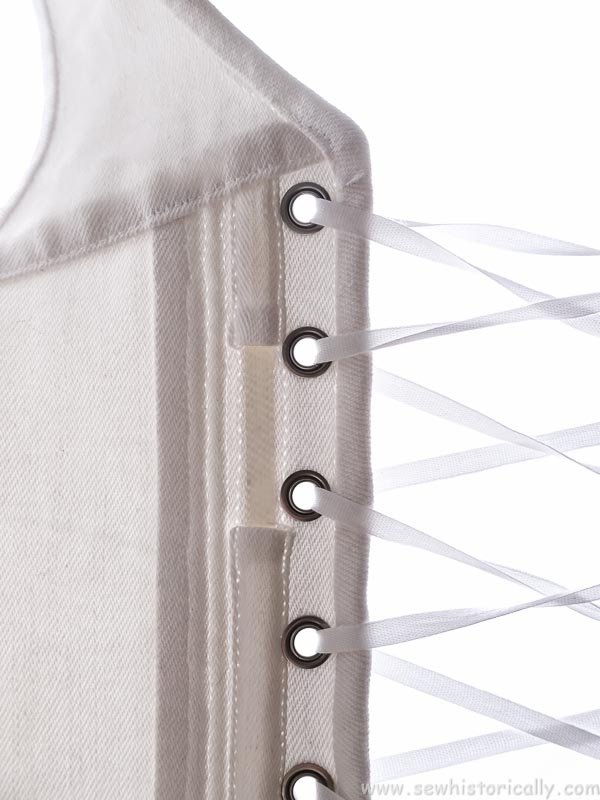
Unboned Corsets & Wrinkling
As you can see in the pictures, my almost unboned corset waist wrinkles, especially at the sides.
‘Don’t be afraid that the unboned portion will wrinkle with each movement, for that is really so and it would be strange if it didn’t, but it curls up but slightly on account of the gentle pressure of the garters, which are fastened to the direct front and sides, just as they are to all corsets.
By the way, garters are as much a feature of the athletic corset as they are of any other kind […] The elastics serve to hold the stays down, and the stockings up and do not in any way add stiffness to the original pliability.’ (San Francisco Call, 1903)
Related: Edwardian Athletic Corsets For The Edwardian Sportswoman
Heavily Boned Health Corsets – Not All Health Corsets Were Real Health Corsets!
However, not all health corsets were good for the health because they were as heavily boned as other corsets!
‘Will any dress reformer explain to me the difference between a corset that is called a corset and a waist that is theoretically made with cords, but which really contains steels in front, sides, and back that are quite as heavy and rigid as a properly constructed corset? The reformer appeases her conscience by having the so-called waist buttoned in front, but at the same time places a heavy steel in a casing just behind it.’ (Talk Upon Practical Subjects, 1895)
Button Closure
Edwardian health corset usually had a button closure at the front instead of the typical corset busk:
‘Such waists are usually made to button in the front’ (Corsets And Close-Fitting Patterns, 1915).
But they had no ordinary machine- or hand-sewn buttonholes. Instead the fabric was folded to create buttonholes! These buttonholes are much stronger than ordinary sewn buttonholes because corset buttonholes need to be strong. Here‘s a detail picture of the button closure at the front, and here‘s a close-up of the button closure at the shoulder. The buttons were also not sewed on but attached with tapes like here.
‘The buttons are attached to tapes which are securely fastened to the garment, to prevent tearing.’ (Perfection Waists, 1895)
Shoulder Straps
Unlike dressier corsets, Edwardian corset waists usually had shoulder straps:
‘Over the shoulders they have narrow straps or armhole portions that serve to support them from the shoulder, rather than from the waist line.
Around the waist line of corset waists are generally placed two rows of buttons – one row at the waist line, and the other ½ to 1 in. below – to which undergarments may be buttoned, thus avoiding the use of tight bands around the wearer’s waist.’ (Corsets And Close-Fitting Patterns, 1915)
Straight Grain Binding
I bound the shoulder straps and all raw edges of the corset with straight grain binding. It’s historically correct to use straight grain binding instead of bias binding. Because homemade antique corsets were usually bound with fabric strips cut on the straight grain to save fabric.
Homemade Vs. Store-Bought Health Corset
‘Corset waists are generally inexpensive, and they are so universally used that they can be purchased in most stores where women’s merchandise is sold. As they require many buttonholes and buttons, much stitching, and additional labor, considerable time must be consumed in making them. For this reason, it is deemed advisable in these sewing lessons not to give instructions for making corset waists.
However, any person who desires to make corset waists will encounter no difficulty in so doing after having thoroughly mastered the drafting of tight linings’. (Corsets And Close-Fitting Patterns, 1915)
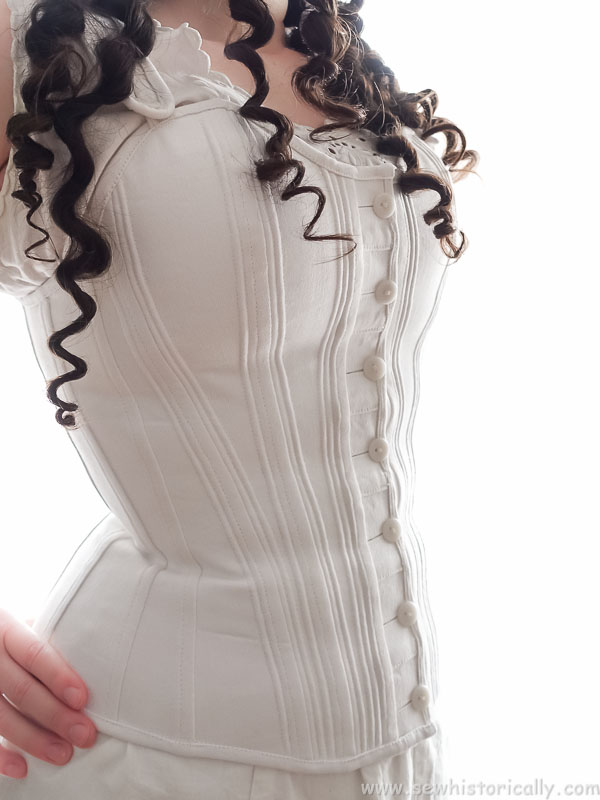
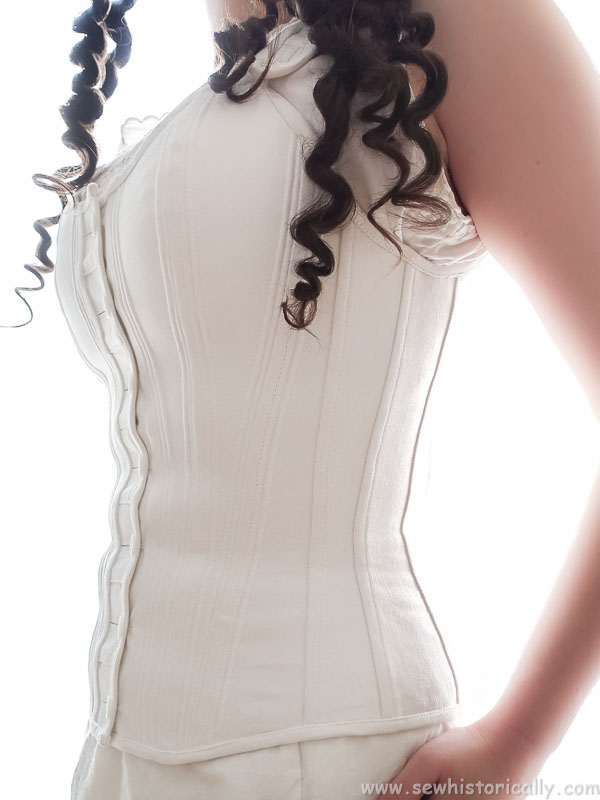
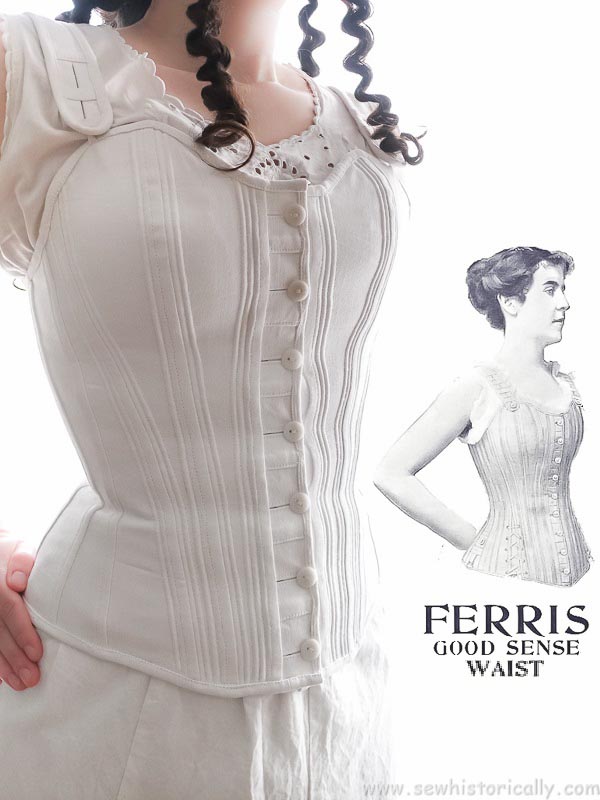

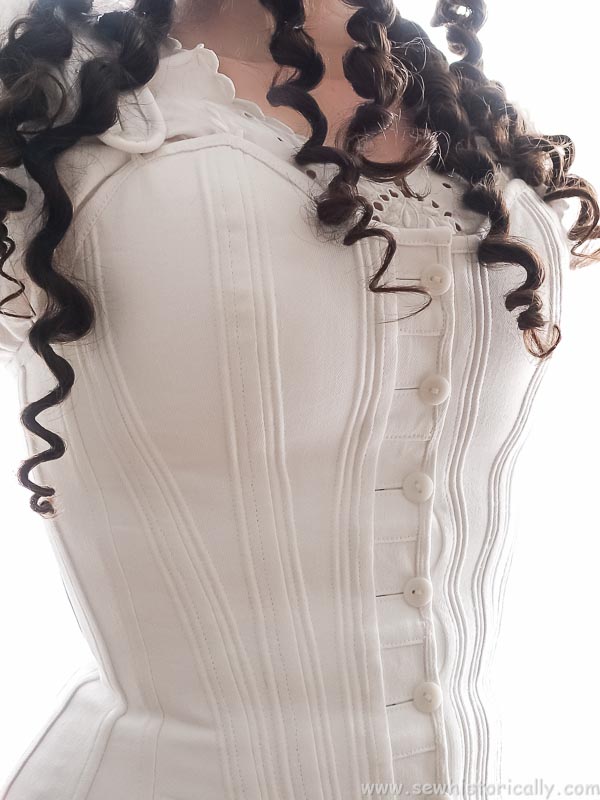
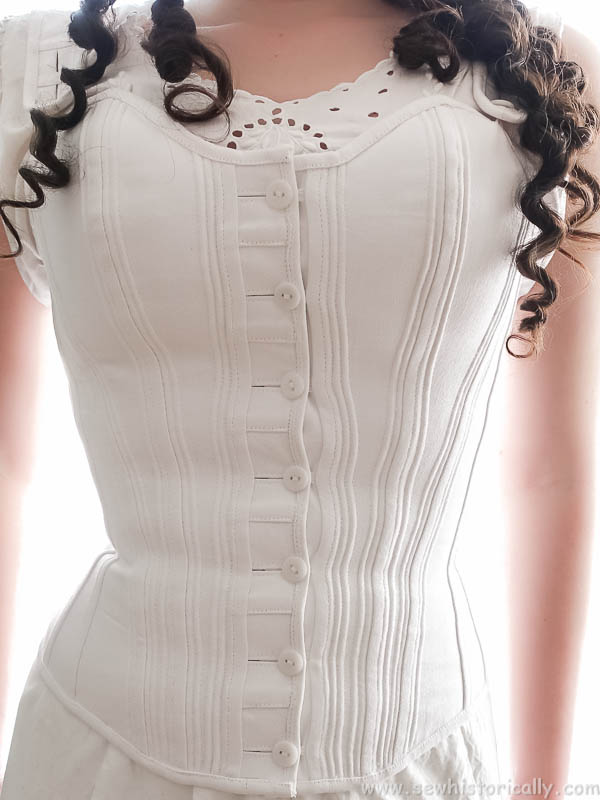
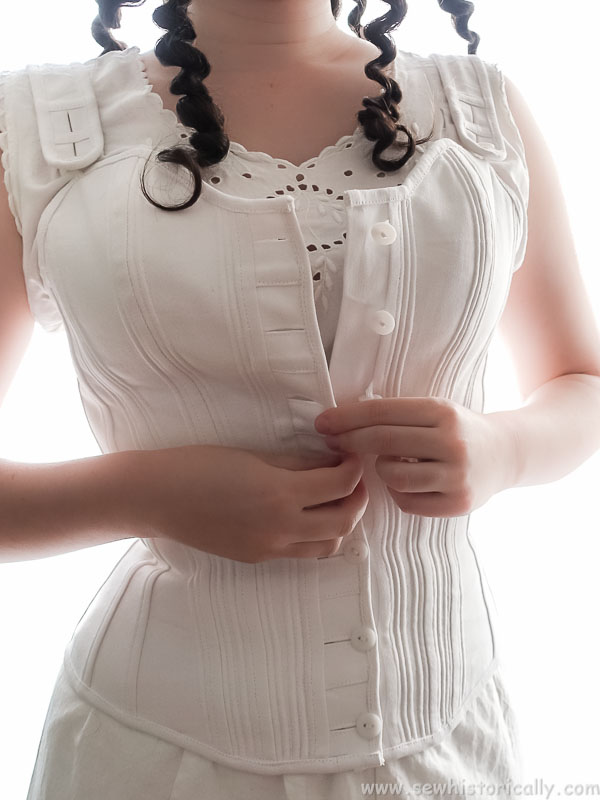
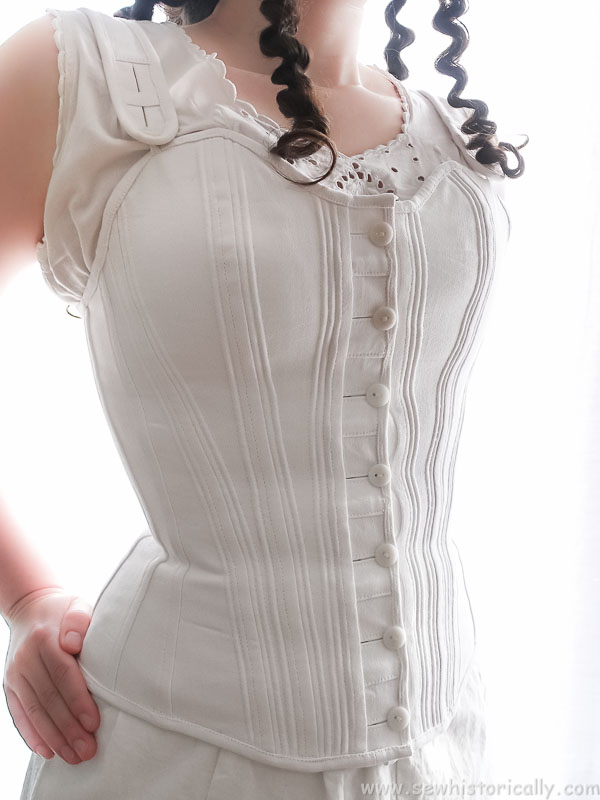
do you have the pattern for this, I have no Idea how to make a 8×10 picture fit me, this corset looks more comfortable the others I have seen and would love to give it a try!
Sorry, I don’t have a pattern for this but there are some great youtube videos about how to scale up and print vintage sewing patterns. Just search for “scale up pdf pattern”. But a word of warning: corded corsets are, in my opinion, less comfortable than boned corsets even if they were called health corsets back then! 😉
Are you able to purchase a health corset?
Do you want to buy an antique or reproduction health corset?
Love your information
Thank you!
Wow, stunning and impressive! Thanks for all the information. I would love to sew a healthy corset for myself but I’m scared of that “scaling up” ?
Thank you so much! 😀 Yes, scaling up and adjusting the pattern is the worst part! 🙂
did you use any special sort of button? or are usual plastic buttons actually strong enough to support the garment? I’d like to make this sort of corset closure for my next corset as I’m just heartily fed up of the whole fighting with the busk thing (I am an odd sort of shape, and fumble fingered, inevitably at least one stud unhooks as I fasten another, the busk then flexes, unpopping another one and it all goes down hill from there)
In the Edwardian era, they used mother of pearl buttons or early types of plastic buttons (like celluloid or galalith). But modern plastic buttons are also strong enough. The problem is usually not the buttons, 😉 but the buttonholes and how the buttons are attached. The buttons were usually attached with cotton tape rather than just sewn, and the buttonholes were also usually created by folding the fabric (but sewn buttonholes also existed). Hope this helps! 🙂